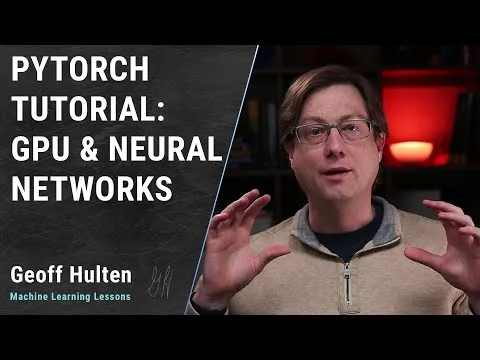
Q Learning Tutorial: Experience Replay 
This tutorial provides an introduction to Q Learning and explores the concept of Experience Replay. Preprocessing, testing and sample replay are discussed in detail. It provides a comprehensive overview of the process of using Experience Replay to improve the performance of Q Learning algorithms. ▼
ADVERTISEMENT
Course Feature
![]() Cost:
Cost:
Free
![]() Provider:
Provider:
Youtube
![]() Certificate:
Certificate:
Paid Certification
![]() Language:
Language:
English
![]() Start Date:
Start Date:
On-Demand
Course Overview
❗The content presented here is sourced directly from Youtube platform. For comprehensive course details, including enrollment information, simply click on the 'Go to class' link on our website.
Updated in [February 21st, 2023]
This course provides an introduction to Q Learning and Experience Replay. It begins with an overview of the fundamentals of Q Learning, including preprocessing and testing. It then moves on to discuss Experience Replay, a technique used to improve the performance of Q Learning algorithms. Finally, the course covers Sample Replay, a method for storing and reusing experiences. By the end of the course, participants will have a better understanding of Q Learning and Experience Replay, and will be able to apply these techniques to their own projects.
[Applications]
After completing this course, users can apply the concepts of Q Learning and Experience Replay to their own projects. They can use the preprocessing techniques to prepare their data for Q Learning, and use the testing techniques to evaluate the performance of their models. Additionally, they can use the Experience Replay and Sample Replay techniques to improve the performance of their models.
[Career Paths]
1. Machine Learning Engineer: Machine Learning Engineers are responsible for developing and deploying machine learning models. They use algorithms such as Q-Learning to create models that can learn from data and make predictions. They also use techniques such as experience replay to improve the accuracy of their models. With the increasing demand for AI-driven solutions, the demand for Machine Learning Engineers is expected to grow significantly in the coming years.
2. Data Scientist: Data Scientists use data to uncover insights and trends. They use techniques such as Q-Learning and experience replay to analyze data and develop models that can be used to make predictions. With the increasing demand for data-driven solutions, the demand for Data Scientists is expected to grow significantly in the coming years.
3. Artificial Intelligence Engineer: Artificial Intelligence Engineers are responsible for developing and deploying AI-driven solutions. They use algorithms such as Q-Learning and experience replay to create models that can learn from data and make predictions. With the increasing demand for AI-driven solutions, the demand for Artificial Intelligence Engineers is expected to grow significantly in the coming years.
4. Robotics Engineer: Robotics Engineers are responsible for developing and deploying robotic systems. They use algorithms such as Q-Learning and experience replay to create models that can learn from data and make decisions. With the increasing demand for robotic solutions, the demand for Robotics Engineers is expected to grow significantly in the coming years.
[Education Paths]
1. Bachelor of Science in Computer Science: This degree path focuses on the fundamentals of computer science, such as programming, algorithms, data structures, and software engineering. It also covers topics such as artificial intelligence, machine learning, and natural language processing. With the increasing demand for AI and ML professionals, this degree path is becoming increasingly popular.
2. Master of Science in Artificial Intelligence: This degree path focuses on the development of AI systems and their applications. It covers topics such as machine learning, deep learning, natural language processing, computer vision, and robotics. It also covers topics such as data mining, optimization, and game theory. This degree path is becoming increasingly popular as AI technology is becoming more widely used in various industries.
3. Doctor of Philosophy in Machine Learning: This degree path focuses on the development of advanced machine learning algorithms and their applications. It covers topics such as supervised and unsupervised learning, reinforcement learning, and neural networks. It also covers topics such as data mining, optimization, and game theory. This degree path is becoming increasingly popular as machine learning technology is becoming more widely used in various industries.
4. Master of Science in Data Science: This degree path focuses on the analysis and interpretation of large datasets. It covers topics such as data mining, machine learning, and natural language processing. It also covers topics such as data visualization, data engineering, and data analytics. This degree path is becoming increasingly popular as data science technology is becoming more widely used in various industries.
Course Provider

Provider Youtube's Stats at AZClass
Discussion and Reviews
0.0 (Based on 0 reviews)
Explore Similar Online Courses

terraform + AWS

Excel 2021&365 Beginners & Intermediate Training: 10-Hour Excel Tutorial Class

Python for Informatics: Exploring Information

Social Network Analysis

Introduction to Systematic Review and Meta-Analysis

The Analytics Edge

DCO042 - Python For Informatics

Causal Diagrams: Draw Your Assumptions Before Your Conclusions

Whole genome sequencing of bacterial genomes - tools and applications

PyTorch Tutorial - Neural Networks & GPU

Applied Deep Learning with PyTorch - Full Course


Start your review of Q Learning Tutorial: Experience Replay